“Unless Wizards releases a new format (Over-Extended?) designed to supersede Legacy, Eternal staples will [rise] in value even more. Sensei’s Divining Top will probably be a $10 card. Aether Vial will be at $15. Force of Will might hit $50.
The release of the new Commander decks will have also helped some of better-but-not-completely-broken casual cards gain value as well. Bribery, for example, is still selling for $4.99…but it’s out of stock. It’s been slowly gaining value for years, and I suspect the days of seeing it available for less than $8 are nearly over.”
– Chas Andres, December 2010
The Long Way Home
That passage was from the last article I wrote about investing in Magic over the long term.
In that column, I attempted to predict what the financial state of the game might look like one, two, and five years into the future. Remember that this was before the Legacy bubble, before the Commander decks were released, and before the announcement of Modern. That was the winter of Jace, the Mind Sculptor and Stoneforge Mystic, when planeswalkers were preordering for $50 and fetchlands could be had for $8-$10.
While my predictions about which Scars of Mirrodin cards might dominate Standard in their second year of legality were laughably wrong, (Hand of the Praetors? Ratchet Bomb? Koth of the Hammer?), most of my casual and Eternal predictions were successful. The buy I pushed on my readers the hardest were sealed boxes of Rise of the Eldrazi, which were easily found at the time for $60-$70. Today, they’re sold out on StarCityGames.com at $200 each. Of course, if I had correctly predicted Modern, I could have made everyone quite a bit more dough—including myself!
Long-term investing is one of the topics I am asked about often, so I figured it was time to reexamine it in our current era of Magic. The game has changed quite radically over the past two and a half years, so if you’re the kind of player or speculator who likes thinking a dozen moves ahead, this article is for you.
Legacy Staples: Rock Solid or Quicksand?
Here’s a four-year chart of Underground Sea’s price, which unfortunately stops in fall of 2012 when the Black Lotus Project stopped collecting data for about six months.
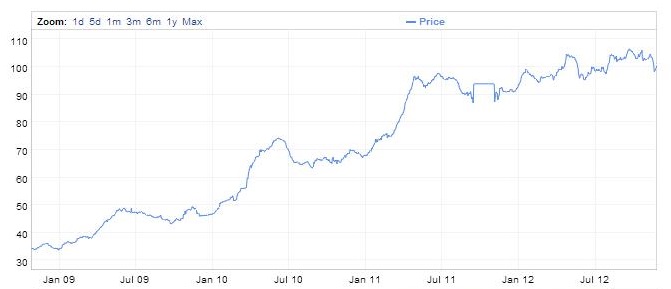
Thanks to the wonderful people over at mtgprice.com, I can see that the card has been stagnant for the past few months as well—the plateau at the end of this graph just sort of continues on.
StarCityGames.com did raise the price of Underground Sea from $150 to $160 this January, but that $10 bump didn’t work on all the duals they tried it on. They also raised the price on Savannah from $100 to $110, for example, but the card came back down to $100 after a few months.
Plateau or not, there has never really been a time in the history of Magic when selling your dual lands was a good idea. They’ve always continued to rise, sometimes quickly and by large amounts. Is that indicative of Legacy cards in general? Let’s check out another long-term staple of the format, Force of Will. This graph covers the same timeframe that the Underground Sea one above does:
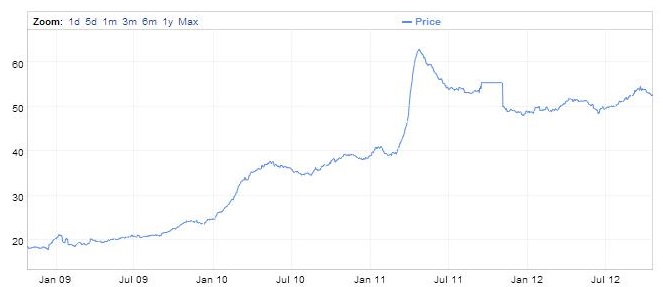
While Underground Sea plateaued, kept rising, and plateaued again, Force of Will never again reached the heights of the spring 2011 Legacy bubble. The mtgprice chart shows the same rough plateau continuing through today, meaning the card has been stable since the fall of 2011.
Of course, these two cards only represent the top tier of Legacy playability. Other Legacy cards that were briefly quite expensive are now worth very little. Check out this chart for Llawan, Cephalid Empress (ignoring the large blocky thing from two months of null data):
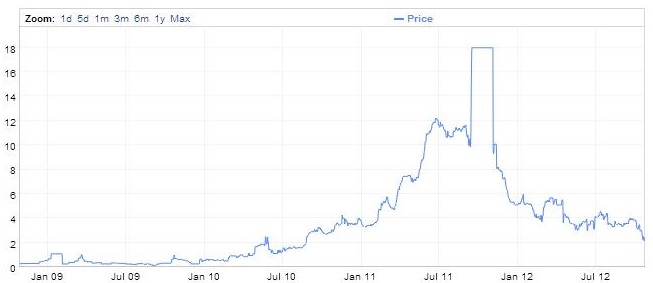
If you decided that your Legacy collection was untouchable during 2011, which many people did, you would have missed out on your only chance to make a profit on Llawan. Heck, she even listed at $20 on SCG for several months that year. Today, she books at just $3.50.
Llawan is a rare case—she used to see a great deal of sideboard play but is now pretty much entirely absent from Legacy. The reason why I brought her up here is to show you that just because a card sees play in Legacy doesn’t mean it will be worth an infinite amount of money forever. Knight of the Reliquary, Mother of Runes, Counterbalance, Pact of Negation, Terravore, Natural Order, and dozens of other Legacy cards have fallen slightly out of favor and seen their values drop—sometimes by large amounts.
Even some staples are starting to scare me a little. It’s true that Force of Will hasn’t gone down in price for years, but is that a good thing? Stagnation during a profitable year isn’t that much different from a loss during a flat sales year. Magic sales are way up right now, and the player base is bigger than ever. Misty Rainforest doubled in price over the past year as Modern has taken off. Casual cards like Darksteel Plate and Celestial Mantle have gone from $1 to $5 as new casual players seek out cards from earlier sets that they missed out on. For good or ill, relatively little of this money and hype has been directed toward cards like Wasteland and Force of Will.
I am personally of the belief that Legacy’s best days are behind it. Part of this is because the style of play in Legacy is radically different from that of any of the newer formats, which might be alienating Magic’s expanding demographic. This is the entire point of Legacy for most of its biggest supporters, of course; it captures the thrill they had playing Magic back when all the games went like that. But while some people are simply drawn to the format because they feel it represents a more skill-testing way to play the game, very few people have played their formative games of Magic during Mark Rosewater New World Order seem to have the Legacy fire. It reminds me of what the Vintage scene was like ten years ago.
It’s also nearly impossible for newer players to even play Legacy considering the massive financial barrier of entry. I’ve heard people argue that you can buy a tier 1 Legacy deck for the price of playing Standard seriously for a season or two, but this doesn’t quite work out in practice. For one, it’s much easier to trade for Standard cards. You can also draft or crack packs to help the cause. Further, Standard is a format that everyone relates to and can be played competitively multiple times a week if you so desire. Finding Legacy tournaments is harder, and the chance to play comes up less.
Legacy is also reasonably far removed from the professional circuit. There’s a Legacy Grand Prix every once in a while, but if you want to play professionally, you don’t really have to understand Legacy in order to make the Pro Tour. Standard, Draft, Sealed, and Modern are all way more important formats to invest time and money into.
Legacy’s appeal, then, is mostly directed toward the players who were already playing Magic when the modern card face was first introduced. At this point, most of these older players have graduated college and moved into the adult world. Many of them have even started families. At this point in a player’s life, having both the money and the time to keep up with Legacy becomes much harder. Most of these players also already have the staples they need to compete.
Does this mean that it’s finally time to sell out of Legacy?
Yes and no. Some cards don’t need to see any competitive play to maintain or even rise in value. At a certain point, they become almost mythical—a creature or spell so powerful that Wizards would never dare print something so good ever again. Check out this chart for Mana Drain:
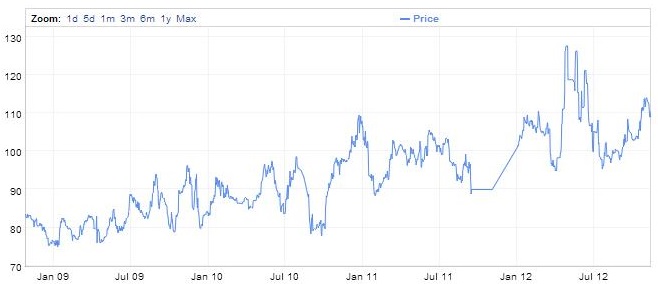
As a quick aside, I actually think Mana Drain has some bust potential. It’s not on the reserved list, and I wouldn’t be shocked to see a foil copy appear in a From the Vaults set at some point soon. The point I’m trying to make, though, is that casual and collector demand (which includes Vintage) is enough to keep the price of this card climbing.
How might that apply to Legacy cards? There are a bunch of format staples that have the same sort of “mythical” appeal that Mana Drain does. Force of Will, Jace, the Mind Sculptor, and all of the dual lands may never go down in price all that much. As long as people want to keep putting together the most powerful decks possible, these cards will be in serious demand. This also goes for casual cards like Demonic Tutor and Strip Mine that are banned in Legacy—people will always find a way to play with these spells, giving them a very high price floor.
As we fall further away from the Legacy era, though, I would expect many of the lesser format staples to continue losing value. This will especially be true for creatures, as Wizards will continue to obsolete the creatures released in the first decade of Magic’s life. Spiritmonger and Morphling were both expensive Legacy cards years ago, and you don’t want to be holding many copies of the next generation of obsolete critters.
So no, it isn’t time to sell your dual lands yet. They should hold their value, but unless there’s a major Legacy resurgence, I wouldn’t expect them to grow much at all over the next two or three years. You can also feel free to keep your Force of Wills and Wastelands. Your other Legacy cards, however? If you’re not using them, it might be time to move on.
Collector’s Items
Truly rare Magic collectables are great long-term bets to hold value.
Rarities from the earliest days of Magic—Beta copies of dual lands, Power Nine, etc.—will always appeal to the collector’s market regardless of what happens to the rest of the game. The collapse of the baseball card market didn’t hurt the price of a Honus Wagner card, the collapse of the comic book market didn’t touch the price of a Superman #1, and a collapse in the Magic card market wouldn’t tank the value of a Black Lotus.
If you are going to invest in cards like these, I highly recommend either obtaining graded copies or getting copies in a condition where they would grade out well. While condition matters a little in terms of valuing a playable card, it matters exponentially more in collectors’ circles. Ask anyone familiar with comics about this—a classic book could be worth $300 or $18,000 depending on the condition. As these historical Magic cards get older and more collectable, condition will start to matter a lot more.
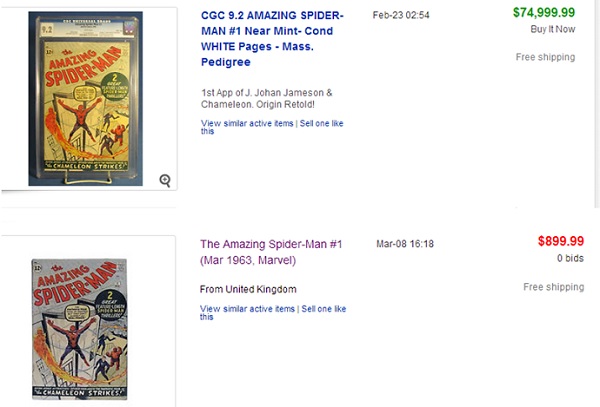
(Note that I am not really a comic book guy, so if I’m missing another major reason for the price disparity in this particular situation, please let me know.)
Of course, the market for high-end graded Magic is already very pricy, and I can’t really recommend cashing out your 401K for a few Beta copies of Black Lotus. This is mostly a recommendation of stability—if you can trade in somehow, you’ll likely be locking in those profits for life regardless of what happens to Magic.
I also think there are some opportunities to exploit the current price of other “pimp” cards—specifically, the price of staple foreign foils.

These cards are scorching hot right now. You know all those Legacy players who already have their staples? The ones in their mid-to-late twenties and early thirties who are the core of the format? Many of them have done well in life but still have (or make) time to play Magic regularly. Right now, they’re pouring money into making their decks as beautiful and terrifying as possible. Again, I don’t think this will last forever. I’m not saying you need to sell your foreign foils, but I don’t think this craze can balloon any further.
At some point, I’d expect these cards to come down to earth a bit in favor of things that appeal to collectors a little more. Near mint copies of Alpha and Beta staples are your best bet for longevity here.
Charting Sealed Boxes
Moving on to a more modest investment opportunity, are sealed boxes always a good long-term investment? Take a look for yourself. Here’s a chart showing the current StarCityGames.com retail price of each sealed box in chronological order from The Dark through Gatecrash. I’ve left out base sets as well as things like Unglued, Unhinged, and Chronicles.
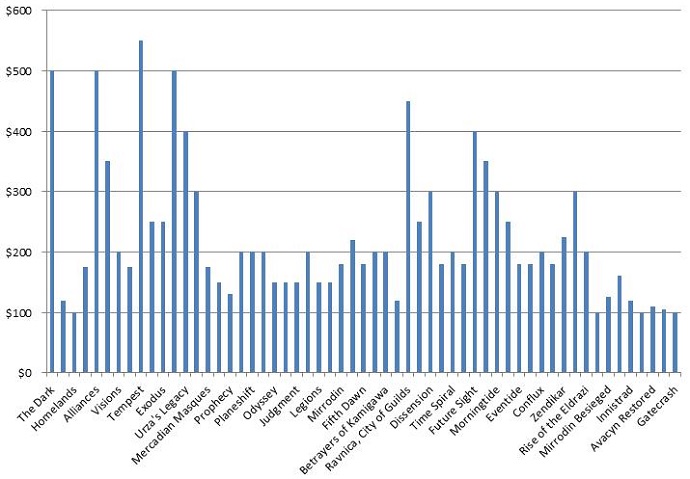
Assuming you are paying around $100 per box, it is hard to go terribly wrong with whatever you buy. The only older sets that still list in the $100 range are Homelands, Fallen Empires, Prophecy, and Saviors of Kamigawa. These are widely considered the worst sets ever printed.
Which sets have the highest sealed box value? The Dark, Alliances, Tempest, Urza’s Saga, Urza’s Legacy, Ravnica: City of Guilds, and Future Sight all sell for $400 or more per box. All of these sets have a number of high-value staples in them that might help recoup the price of the box. Ravnica is also one of the most beloved draft formats ever, which causes sealed boxes of all three sets to be quite desirable.
In terms of recent boxes, Zendikar block is the clear winner. The first set has fetchlands, the second has Jace, and the third has the Eldrazi and a great Draft format. Not only was this a fun block to play, but these packs are chock full of value. Lorwyn boxes are also surprisingly costly, with a bevy of $5 Elf uncommons and Thoughtseize undoubtedly aiding the price.
Looking back about as far as Masques block, it’s clear that boxes tend to stabilize at $150 if the sets don’t contain much value, $200 if they do (or if the set is beloved for other reasons), and quite a bit more if the set is stacked with money cards or venerated as a great overall format.
This being the case, which post-Eldrazi sets seem primed to jump in the future?
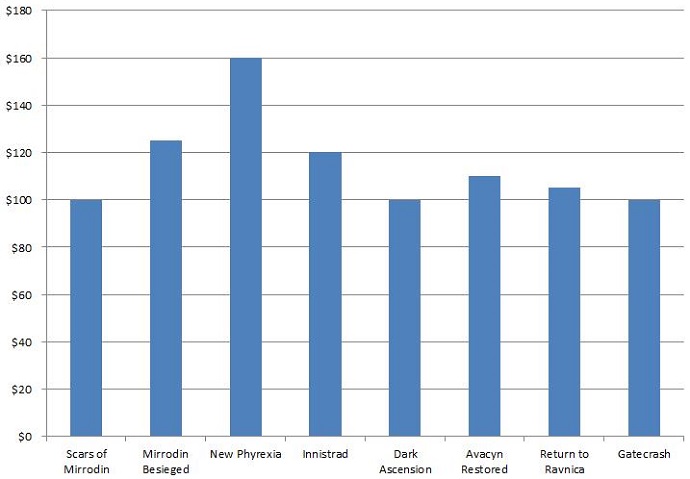
Scars of Mirrodin and Mirrodin Besieged aren’t likely to rise much—they weren’t great Draft formats, and there wasn’t much value in them. New Phyrexia might still have a little room to grow, however, as Phyrexian mana was a powerful and beloved mechanic and this set had some great casual cards in it.
Avacyn Restored is likely going to follow the same trajectory, and I expect boxes of that to rise from $120 to $160 over the next year.
Return to Ravnica and Gatecrash are oozing with long-term potential. While the Draft formats aren’t beloved yet, there’s a chance that the new RGD will go down as one of the best ever. Shocklands are good for long-term value, as are the bevy of excellent casual cards. I’m planning on putting several of each box in my closet for at least three or four years.
Innistrad might be an even better long-term investment, though. It recently won the Rosewater Rumble on Twitter for his best-designed set, and I expect it would be a heavy contender in a poll for the single most beloved Magic set of all time. It has a few staples in it (Snapcaster Mage, Geist of Saint Traft, Liliana of the Veil) and an outstanding Draft format. Snag a few of these boxes and sock them away while you have the chance.
The Second Casual Boom
Going long term on competitive cards is a shot in the dark because we have no way of knowing what any format is going to look like several years down the line. What about casual Magic, though?
When Commander exploded in popularity, dozens of one-dollar cards jumped into the $3-$10 range. The amount of money I made from this boom dwarfs everything I’ve ever made speculating, as I already had four or more copies of each of those cards socked away for personal use before the jump.
What current cards are primed to make a similar leap in the future?
Well, some cards have already climbed in price since the last time you checked. Here’s a list of the most surprising casual gainers from Scars of Mirrodin forward:
- Asceticism – $5
- Darksteel Plate – $4
- Vorinclex, Voice of Hunger – $6
- Caged Sun – $4
- Primordial Hydra – $7
- Parallel Lives – $4
- Champion of Lambholt – $3
- Akroma’s Memorial – $6
- Chromatic Lantern – $3
All of these cards are likely to be the next vanguard of casual staples, and they will probably rise a little over the next few years unless they’re reprinted.
Here’s a partial list of other casual cards I’d like to sock away in my long-term box because I think they have room to grow:
- Mimic Vat
- Archon of Justice
- Chancellor of the Spires
- Deadeye Navigator
- Hoarding Dragon
- Luminarch Ascension
- Expedition Map
- All Five Primordials
- Thespian’s Stage
- Assemble the Legion
- Gilded Lotus
- Gavony Township
- Lurking Predators
- Command Tower
- Elesh Norn, Grand Cenobite
- Sword of Feast and Famine
- Sun Titan
- Grave Titan
- Phyrexian Metamorph
- Massacre Wurm
- Rune-Scarred Demon
- Sheoldred, Whispering One
- Craterhoof Behemoth
- Gisela, Blade of Goldnight
- Blightsteel Colossus
If you have other casual cards you’re socking away, let us know in the comments.
Overall, I can’t recommend investing too heavily in casual spells, especially creatures. Wizards of the Coast is designing and developing so much more for Commander now that older spells are being obsoleted more often than ever. When looking for great casual cards in general, focus on incredibly powerful creatures (Titans, Praetors, Primordials, Eldrazi), doubling effects (Caged Sun, Assemble the Legion), and Tutoring/ramp (Rune-Scarred Demon, Hoarding Dragon). Being part of a beloved tribe or having a truly unique ability is also a major advantage.
To be honest, I do worry a little about Commander over the next two years. I still love tinkering with my decks, but I rarely actually play the format anymore because it’s gotten kind of grindy and tedious. I see games at my local shop all the time, which is encouraging, but I still feel as if there are a lot of lapsed Commander players who have grown disillusioned with the format. I wouldn’t be shocked to see a different casual variant—or even a twist on Commander—start to gain momentum at some point in the near future. If this happens, the prices on all of these casual hits will be upended, so stay alert.
This Week’s Trends
– Ajani Vengeant’s appearance in Modern Jund was the big news last weekend. There are a ton of these running around, but even still I bought a stack of them at $3.50 when the news broke. So far, I haven’t had any luck moving them—most pros who need the card seem to have a set already. If you invested in these, flip them quickly.
– A black/white/red/green deck 4-0’d a Modern daily last week with four copies of Glittering Wish in the maindeck. While the deck also had a bevy of expensive staples in it, Glittering Wish is a cheap card from an under-opened set and will likely jump due to speculation alone. Pick up a set now if they’re still cheap—$1.49 on StarCityGames.com at the time I’m writing this.
– Revenge of the Hunted showed up in a weird-looking 4-0 deck in Standard. While I don’t recommend moving in, you might want to take these out of your bulk boxes and put them into your binder.
– People have been asking me about Gideon, Champion of Justice now that he’s down to just $7. I wouldn’t buy even a single copy until I see him actually start appearing in winning decks. Stay away.
– Someone found a spoiler from Duels of the Planeswalkers 2014 called Shadowborn Demon. It will likely be a mythic rare in M14. It plays well with Restoration Angel, but both cards won’t be in Standard together for very long and I don’t see much Modern application.
– Craterhoof Behemoth is up to almost 20 tickets online but is still just $8 on SCG. This guy could jump back to $15 again as soon as this week.
Until next time –
– Chas Andres
